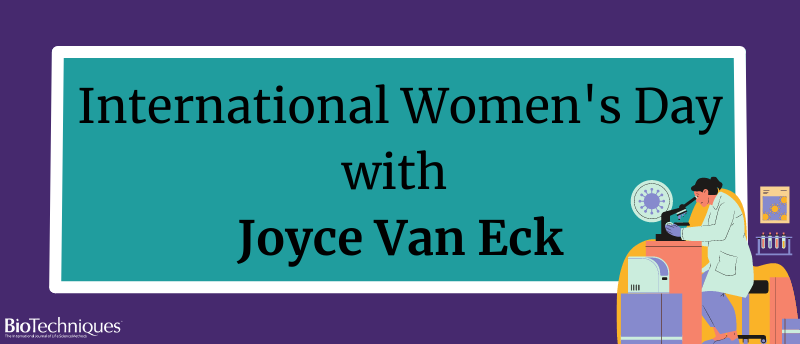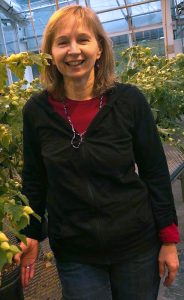International Women’s Day with Joyce Van Eck

In our International Women’s Day series, we talk to women in STEM to hear more about their research and their interests away from the lab bench.
 Joyce Van Eck (right) is a researcher at the Boyce Thompson Institute (NY, USA) looking at gene function in model plant species including the tomato. Here, Van Eck writes about the realization that medicine was not the career for her whilst doing dissections in class, but an interest in genetics led her to a successful research career in plant biotechnology.
Joyce Van Eck (right) is a researcher at the Boyce Thompson Institute (NY, USA) looking at gene function in model plant species including the tomato. Here, Van Eck writes about the realization that medicine was not the career for her whilst doing dissections in class, but an interest in genetics led her to a successful research career in plant biotechnology.
What excites you most about your job?
What excites me the most is that my work in plant biotechnology and crop improvement has the potential to benefit agricultural production systems and play a role in ensuring food security.
What are some of the best and worst parts of your job?
The best parts of my job are the excitement of discovery and being involved in shaping the futures of young scientists. My least favorite part is writing grant proposals to seek funding to support my research. It is all consuming putting together grant proposals – you have to put a lot of things at work and in your life on hold to meet grant proposal deadlines. All the hard work doesn’t guarantee you’ll be successful at receiving funding and while a proposal might be well received by reviewers of a funding agency, it might not be recommended for funding. You do have the option to submit a revised version again, but most agencies only have calls for proposals on an annual basis.
What characteristics of these food crops are you hoping to improve through your research?
I decided to focus my work on potatoes and tomatoes because they are major food crops worldwide. I’m not working on potatoes any longer, but my early work was on enhanced nutritional content, specifically beta-carotene. As for tomato, we are using it as a model plant species to understand gene function and how it relates to phenotypes (traits) such as plant growth habit, fruit characteristics and productivity (yield). Our intention is that what we learn about gene function and the resultant phenotypes in tomatoes can be applied to improve other plant species.
Could you tell me more about the aims of The Physalis Improvement Project? How did you become interested in Physalis?
I became interested in Physalis through our work with tomato, as they are related and in the same family, the Solanaceae family, along with potato, pepper, eggplant and many other plant species. We were using gene editing with CRISPR/Cas9 in tomato as a reverse genetics approach to knock out the expression of genes, and then observe the phenotypes to better understand gene function. Through this work, we realized that CRISPR/Cas9 could be a very useful tool for fast-tracking improvement, like fast-tracking the domestication of underutilized plant species that have the potential to be new food crops. So, to put this idea into practice and to demonstrate the feasibility in a species related to the tomato, we chose the Physalis, namely groundcherry and goldenberry. We felt that in addition to using them to answer our fundamental research questions, if we could improve them, especially to have a more compact plant growth habit, there was potential for them to become specialty fruit crops in the US. It would also give consumers another fruit option to help diversify their diets.
The Physalis Improvement Project combines the research efforts I described above with a community science program. I wanted to get first-hand feedback from farmers, home gardeners and consumers on their likes and dislikes of growing and eating groundcherry and goldenberry to help guide improvement efforts.
What did you always want to be?
I always wanted to be either a scientist or a doctor, specifically a pediatrician, but when I got to college and I had classes where we were doing dissections, I found I really didn’t like doing them. I realized doing these types of activities were an important part of becoming a doctor, but I dreaded going to classes when dissections were part of the labs. I was very interested in genetics, so I started looking into other areas to apply my interests and came upon plant breeding. I then learned about plant biotechnology and decided this was where I wanted to spend my career.
What challenges do you face day to day as a woman and how do you balance these with your working life?
I don’t have any specific challenges I face related to being a woman in science. I don’t think of myself as a woman scientist, but I think of myself as a scientist who just happens to be a woman and I face the same challenges as other scientists.
Who is your inspirational hero?
It’s not any one person, it’s more of the qualities in people that inspire me. People who are honest, kind, considerate, and accepting of the differences in others are inspirational to me. My heroes are those who want to make a difference in the world and go out and do it.